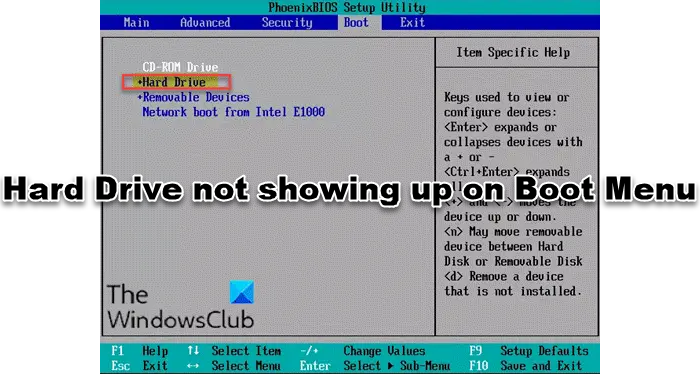If when you turn on your Windows 11/10 computer and it fails to boot successfully and you access the BIOS/UEFI and notice that the disk drive (HDD/SSD) is not showing or listed on the boot menu, then this post is intended to help you. In this post, we will present some solutions you can try to help you fix this issue so that you can have your computer up and running in no time.
Hard Drive not showing up on Boot Menu

If your Hard drive does not show up on the boot menu in Windows 11/10, you can try our recommended solutions below, which are listed in no particular order, and see if that helps to resolve the issue.
- Update or reinstall disk drive drivers
- Check cable and USB port connection
- Initialize disk drive
- Update BIOS
- Turn on USB port in BIOS
Let’s take a look at the description of the process involved in relation to each of the listed solutions.
1] Update or reinstall disk drive drivers
A damaged or outdated device driver may be the cause. In this case, you can try to update/reinstall disk drive drivers and see whether the problem is fixed or not.
You can try the next solution if this solution doesn’t fix the issue.
2] Check cable and USB port connection
You need to connect two different power cords to use a disk drive with your computer. One SATA cable will be between the motherboard and the disk drive. The second SATA cable will be between the hard disk and SMPS or any other source, where it can get the power. If you make any mistake, your computer won’t be able to detect the disk drive. Also, it would be best if you plugged in the SATA cable on the right port on the MOBO.
You might encounter this problem if the HDD/SSD data cable gets loose or the USB port is dead. In this case, you can try changing the cable or the USB port to see if it can be detected.
3] Initialize disk drive
When a disk drive is not initialized, you cannot save data on it and BIOS cannot recognize the disk drive which can be the reason for the issue. This issue often happens to a new disk drive. In this case, you can try to initialize the disk drive and see if that helps.
Read: SSD not showing up in Disk Management or BIOS in Windows.
4] Update BIOS
You might want to update your BIOS and see if that helps you.
Fix: Hard Drive Not installed problem.
5] Turn on USB port in BIOS
You might encounter the error if your drive is not detected successfully because the USB port is turned off in BIOS. Some motherboard manufacturers disable unused ports in the BIOS by default. In this case, you must access the BIOS setup to verify its current state.
Note: BIOS setup varies from motherboard to motherboard. If you have trouble navigating the BIOS, review the documentation that came with your computer.
Once you’re in the BIOS environment and you see the USB port is turned off, do the following to turn it on:
- Use the arrow key to select Advanced > Onboard Devices or Integrated Peripherals from the menu and hit Enter.
- Select USB Controller.
- Press + or – to change the setting to Enabled.
- Next, press F10 to enable the USB ports and exit the BIOS.
You can restart your computer and see if it boots successfully as the disk drive will now be listed on the boot menu.
Hopefully, any of these solutions will work for you.
Leave a Reply